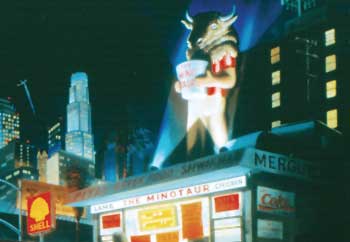![[Metroactive Arts]](/arts/gifs/art468.gif)
[ Arts Index | Silicon Valley | Metroactive Home | Archives ]
Circles Of Hell
At the San Jose Museum of Art, Sandow Birk escorts Dante into the modern world
By Michael S. Gant
UNASSUMING and casually dressed, artist Sandow Birk doesn't look like someone who just spent years retracing the steps of an immortal poetic journey. Birk, a Southern California resident and avid surfer, has recently completed a daunting task: reimagining Dante's Divine Comedy. Not just Inferno but Purgatorio and Paradiso as well.
Birk, an accomplished painter with a wide range of well-absorbed influences, began his project by dipping into Gustave Doré's illustrated version of Dante--a 19th-century coffee-table bestseller. With a sharp eye for the satiric connections between modern society and late-medieval Florence, Birk posits the poet as a SoCal slacker with a backpack and baggy jeans. Virgil, his guide, appears as a sidewalk sage who might just be a crazy street person.
Working in pen and ink, Birk meticulously copied (with some exceptions) Doré's densely hatched compositions,, then added contemporary urban backdrops. In his illustration of the Minotaur (Canto XII, Inferno) on a rocky outcropping, for instance, the mythic creature becomes a giant advertising statue perched atop a Greek fast food stand.
Birk's Inferno looks suspiciously like Los Angeles--there is no hell, after all, like a freeway at rush hour, especially when enfolded in the batlike wings of Lucifer himself, his elbows resting on what looks like the 405 at 4:05pm on a Friday. In the most striking composition, Dante and Virgil stand on a narrow cliff face beneath the letters of the Hollywood sign and survey the Eighth Circle of Hell, an infinitely receding plain of lights like a million distant flames of perdition.
Purgatorio unfolds in San Francisco, whose hills represent the hard climb of redemption. In addition to such landmarks as the TransAmerica building, the Sutro tower and a BART escalator, Birk uses a real-life North Beach strip club called the Garden of Eden to represent the biblical garden.
Paradise, the climax of Dante's spiritual quest, lies in a modern New York that encompasses all cultures, people and languages. Departing from Doré's and Dante's traditional Catholic vision, Birk liberally uses symbols of the major religions (Hindu icons, a Mayan calendar wheel, worshippers at Mecca) to represent the final approach to the ineffable.
Unfortunately, Birk can't quite overcome the same problem that sinks Doré. Basically, drawings of bodies writhing in agony are just more compelling than images of angels bathed in ethereal light.
Birk's work is represented at the museum by 50 of his pen-and-ink originals plus some paintings from the project. The three full-size versions of Inferno, Purgatorio and Paradiso are especially powerful. Birk's Inferno jams together Northern and Southern California (and a little of New York, too) with all our fears of natural apocalypses leading to a traffic jam that looks disturbingly like the ones leading away from Hurricane Rita. His mountain of Purgatory replicates a Breughel the Elder painting of the Tower of Babel with modern touches like circling helicopters. Paradise is an East Coast metropolis seen from the brow of a forested hill, like a settlement in the clearing of a Hudson River School landscape.
But the show doesn't really come alive unless you study the textual adaptation that Birk and collaborator Marcus Sanders created to accompany the images. Neither is a student of Italian, so they riffed off a variety of English translations. Remarkably, they have achieved a very readable free-verse poem that does justice to the original even while adding some canny contemporary references.
I suppose that scholars would object to the breezy metaphors, but Birk and Sanders have a strong sense of the vernacular. A line like "I saw a sinner who had been ripped / open like a bag of potato chips or Cheetos; / he was split from his head to asshole" is at least as effective as Longfellow's "A cask by losing centre-piece or cant / Was never shattered so, as I saw one / Rent from the chin to where one breaketh wind."
[ Silicon Valley | Metroactive Home | Archives ]
![]()

Infernally Good: Sandow Birk's take on Dante mixes ancient myth and modern consumerism.
Sandow Birk's Divine Comedy shows through Jan. 8 at the San Jose Museum of Art, 110 S. Market St.; 408.294.2787. Birk's 'Divine Comedy' is published by Chronicle Books.
Send a letter to the editor about this story to letters@metronews.com.
From the October 5-11, 2005 issue of Metro, Silicon Valley's Weekly Newspaper.